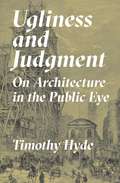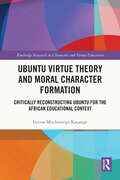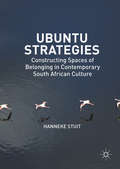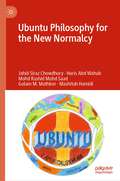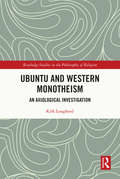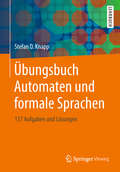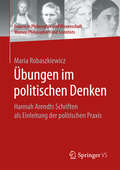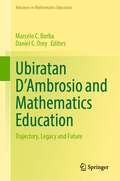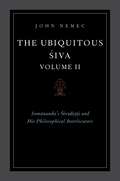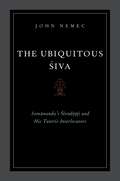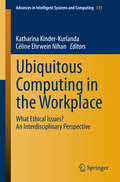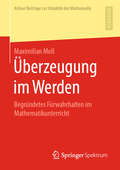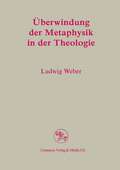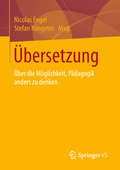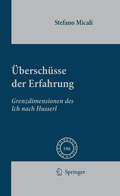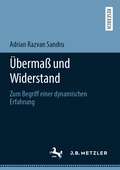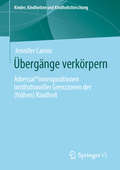- Table View
- List View
The Ugliness of Moses Mendelssohn: Aesthetics, Religion & Morality in the Eighteenth Century (Routledge Jewish Studies Series)
by Leah HochmanThe Ugliness of Moses Mendelssohn examines the idea of ugliness through four angles: philosophical aesthetics, early anthropology, physiognomy and portraiture in the eighteenth-century. Highlighting a theory that describes the benefit of encountering ugly objects in art and nature, eighteenth-century German Jewish philosopher Moses Mendelssohn recasts ugliness as a positive force for moral education and social progress. According to his theory, ugly objects cause us to think more and thus exercise—and expand—our mental abilities. Known as ugly himself, he was nevertheless portrayed in portraits and in physiognomy as an image of wisdom, gentility, and tolerance. That seeming contradiction—an ugly object (Mendelssohn) made beautiful—illustrates his theory’s possibility: ugliness itself is a positive, even redeeming characteristic of great opportunity. Presenting a novel approach to eighteenth century aesthetics, this book will be of interest to students and scholars in the fields of Jewish Studies, Philosophy and History.
Ugliness and Judgment: On Architecture in the Public Eye
by Timothy HydeA novel interpretation of architecture, ugliness, and the social consequences of aesthetic judgmentWhen buildings are deemed ugly, what are the consequences? In Ugliness and Judgment, Timothy Hyde considers the role of aesthetic judgment—and its concern for ugliness—in architectural debates and their resulting social effects across three centuries of British architectural history. From eighteenth-century ideas about Stonehenge to Prince Charles’s opinions about the National Gallery, Hyde uncovers a new story of aesthetic judgment, where arguments about architectural ugliness do not pertain solely to buildings or assessments of style, but intrude into other spheres of civil society.Hyde explores how accidental and willful conditions of ugliness—including the gothic revival Houses of Parliament, the brutalist concrete of the South Bank, and the historicist novelty of Number One Poultry—have been debated in parliamentary committees, courtrooms, and public inquiries. He recounts how architects such as Christopher Wren, John Soane, James Stirling, and Ludwig Mies van der Rohe have been summoned by tribunals of aesthetic judgment. With his novel scrutiny of lawsuits for libel, changing paradigms of nuisance law, and conventions of monarchical privilege, he shows how aesthetic judgments have become entangled in wider assessments of art, science, religion, political economy, and the state.Moving beyond superficialities of taste in order to see how architectural improprieties enable architecture to participate in social transformations, Ugliness and Judgment sheds new light on the role of aesthetic measurement in our world.
Ugliness and Judgment: On Architecture in the Public Eye
by Timothy HydeA novel interpretation of architecture, ugliness, and the social consequences of aesthetic judgmentWhen buildings are deemed ugly, what are the consequences? In Ugliness and Judgment, Timothy Hyde considers the role of aesthetic judgment—and its concern for ugliness—in architectural debates and their resulting social effects across three centuries of British architectural history. From eighteenth-century ideas about Stonehenge to Prince Charles’s opinions about the National Gallery, Hyde uncovers a new story of aesthetic judgment, where arguments about architectural ugliness do not pertain solely to buildings or assessments of style, but intrude into other spheres of civil society.Hyde explores how accidental and willful conditions of ugliness—including the gothic revival Houses of Parliament, the brutalist concrete of the South Bank, and the historicist novelty of Number One Poultry—have been debated in parliamentary committees, courtrooms, and public inquiries. He recounts how architects such as Christopher Wren, John Soane, James Stirling, and Ludwig Mies van der Rohe have been summoned by tribunals of aesthetic judgment. With his novel scrutiny of lawsuits for libel, changing paradigms of nuisance law, and conventions of monarchical privilege, he shows how aesthetic judgments have become entangled in wider assessments of art, science, religion, political economy, and the state.Moving beyond superficialities of taste in order to see how architectural improprieties enable architecture to participate in social transformations, Ugliness and Judgment sheds new light on the role of aesthetic measurement in our world.
Ugliness and Judgment: On Architecture in the Public Eye
by Timothy HydeA novel interpretation of architecture, ugliness, and the social consequences of aesthetic judgmentWhen buildings are deemed ugly, what are the consequences? In Ugliness and Judgment, Timothy Hyde considers the role of aesthetic judgment—and its concern for ugliness—in architectural debates and their resulting social effects across three centuries of British architectural history. From eighteenth-century ideas about Stonehenge to Prince Charles’s opinions about the National Gallery, Hyde uncovers a new story of aesthetic judgment, where arguments about architectural ugliness do not pertain solely to buildings or assessments of style, but intrude into other spheres of civil society.Hyde explores how accidental and willful conditions of ugliness—including the gothic revival Houses of Parliament, the brutalist concrete of the South Bank, and the historicist novelty of Number One Poultry—have been debated in parliamentary committees, courtrooms, and public inquiries. He recounts how architects such as Christopher Wren, John Soane, James Stirling, and Ludwig Mies van der Rohe have been summoned by tribunals of aesthetic judgment. With his novel scrutiny of lawsuits for libel, changing paradigms of nuisance law, and conventions of monarchical privilege, he shows how aesthetic judgments have become entangled in wider assessments of art, science, religion, political economy, and the state.Moving beyond superficialities of taste in order to see how architectural improprieties enable architecture to participate in social transformations, Ugliness and Judgment sheds new light on the role of aesthetic measurement in our world.
Ugliness and Judgment: On Architecture in the Public Eye
by Timothy HydeA novel interpretation of architecture, ugliness, and the social consequences of aesthetic judgmentWhen buildings are deemed ugly, what are the consequences? In Ugliness and Judgment, Timothy Hyde considers the role of aesthetic judgment—and its concern for ugliness—in architectural debates and their resulting social effects across three centuries of British architectural history. From eighteenth-century ideas about Stonehenge to Prince Charles’s opinions about the National Gallery, Hyde uncovers a new story of aesthetic judgment, where arguments about architectural ugliness do not pertain solely to buildings or assessments of style, but intrude into other spheres of civil society.Hyde explores how accidental and willful conditions of ugliness—including the gothic revival Houses of Parliament, the brutalist concrete of the South Bank, and the historicist novelty of Number One Poultry—have been debated in parliamentary committees, courtrooms, and public inquiries. He recounts how architects such as Christopher Wren, John Soane, James Stirling, and Ludwig Mies van der Rohe have been summoned by tribunals of aesthetic judgment. With his novel scrutiny of lawsuits for libel, changing paradigms of nuisance law, and conventions of monarchical privilege, he shows how aesthetic judgments have become entangled in wider assessments of art, science, religion, political economy, and the state.Moving beyond superficialities of taste in order to see how architectural improprieties enable architecture to participate in social transformations, Ugliness and Judgment sheds new light on the role of aesthetic measurement in our world.
Ubuntu Virtue Theory and Moral Character Formation: Critically Reconstructing Ubuntu for the African Educational Context (Routledge Research in Character and Virtue Education)
by Grivas Muchineripi KayangeThis book investigates the ubuntu theory-based conception of virtue and moral character formation in the northern, western, and eastern regions of Africa, suggesting a critical reconstruction of ubuntu by conceptualising the four different forms of practices in moral character formation. Arguing for the critical reconstruction of ubuntu virtue theory as more nuanced than simply the standard ubuntu normative virtue theories (which give priority to the community as the sole locus for understanding virtues and character formation in Africa), the book builds a comprehensive model of virtue and moral character formation that draws insights from the reconstructed notion of ubuntu and other theories within and beyond the African thought. Chapters feature experience from across Africa including Malawi, Zambia, Zimbabwe, Uganda, Kenya, and South Africa, and centre on topics such as traditional cultural views and practices, political systems in various nations, neoliberalist thought, and primary, secondary and tertiary education systems in Africa and further afield. This is a valuable resource for scholars, academics, and postgraduate students, working in the fields of moral and values education, philosophy of education, and the theory of education more broadly. Those also interested in educational psychology may also find the volume of interest.
Ubuntu Virtue Theory and Moral Character Formation: Critically Reconstructing Ubuntu for the African Educational Context (Routledge Research in Character and Virtue Education)
by Grivas Muchineripi KayangeThis book investigates the ubuntu theory-based conception of virtue and moral character formation in the northern, western, and eastern regions of Africa, suggesting a critical reconstruction of ubuntu by conceptualising the four different forms of practices in moral character formation. Arguing for the critical reconstruction of ubuntu virtue theory as more nuanced than simply the standard ubuntu normative virtue theories (which give priority to the community as the sole locus for understanding virtues and character formation in Africa), the book builds a comprehensive model of virtue and moral character formation that draws insights from the reconstructed notion of ubuntu and other theories within and beyond the African thought. Chapters feature experience from across Africa including Malawi, Zambia, Zimbabwe, Uganda, Kenya, and South Africa, and centre on topics such as traditional cultural views and practices, political systems in various nations, neoliberalist thought, and primary, secondary and tertiary education systems in Africa and further afield. This is a valuable resource for scholars, academics, and postgraduate students, working in the fields of moral and values education, philosophy of education, and the theory of education more broadly. Those also interested in educational psychology may also find the volume of interest.
Ubuntu Strategies: Constructing Spaces of Belonging in Contemporary South African Culture
by Hanneke StuitHanneke Stuit delves into Ubuntu's relevance both in South Africa and in Western contexts, analyzing the political and ethical ramifications of the term's uses in different media including literature, cartoons, journalistic fiction, commercials, commodities, photography, and political manifestos in contemporary South African culture.
Ubuntu Philosophy for the New Normalcy
by Jahid Siraz Chowdhury Haris Abd Wahab Mohd Rashid Mohd Saad Golam M. Mathbor Mashitah HamidiThe book is about Ubuntu—loosely translated—I am because we are—or, our common humanity in Zulu, about Unity, and global solidarity. It proves again how alike and universal we are as societies across the globe despite this deadly pandemic. On a personal and social basis, each of the six chapters is a call to action to find commonality, and this is the third book of Jahid’s amelioration on Covid-19 Trilogy. And the Appendix is something special for the readership. Ubuntu tells us about the Indigenous healing keys: empathy, compromise, learning, non-violence, change, forgiveness, restorative justice, love, spirituality and hope. The book was written by a highly diverse team of contributors, both from the Global South and North, and is multidisciplinary in nature, and attempting of Commoning the Communities. The authors hail from the fields of social work, anthropology, and education, and have been working with local communities in the ongoing struggle to identify and address complicit oppression and inequalities. Offering a beacon of hope for today and tomorrow, the book will appeal to social science researchers, policy planners, and the general public alike
Ubuntu and Western Monotheism: An Axiological Investigation (Routledge Studies in the Philosophy of Religion)
by Kirk LougheedThis book offers a unique comparative study of ubuntu, a dominant ethical theory in African philosophy, and western monotheism. It is the first book to bring ubuntu to bear on the axiology of theism debate in contemporary analytic philosophy of religion. A large motivating force behind this book is to explore the extent to which there is intersubjective ethical agreement and disagreement between ubuntu and Western worldviews like monotheism and naturalism. First, the author assesses the various arguments for anti-theism and pro-theism on the assumption that ubuntu is true. Ubuntu’s communitarian focus might be so different from the Western tradition that it completely changes how we evaluate theism and atheism. Second, the author assesses the advantages and disadvantages of the truth of ubuntu for the world. Third and finally, he assesses the axiological status of faith for both monotheism and ubuntu. Ubuntu and Western Monotheism will be of interest to scholars and advanced students specializing in philosophy of religion, African religion and philosophy, and religious ethics.
Ubuntu and Western Monotheism: An Axiological Investigation (Routledge Studies in the Philosophy of Religion)
by Kirk LougheedThis book offers a unique comparative study of ubuntu, a dominant ethical theory in African philosophy, and western monotheism. It is the first book to bring ubuntu to bear on the axiology of theism debate in contemporary analytic philosophy of religion. A large motivating force behind this book is to explore the extent to which there is intersubjective ethical agreement and disagreement between ubuntu and Western worldviews like monotheism and naturalism. First, the author assesses the various arguments for anti-theism and pro-theism on the assumption that ubuntu is true. Ubuntu’s communitarian focus might be so different from the Western tradition that it completely changes how we evaluate theism and atheism. Second, the author assesses the advantages and disadvantages of the truth of ubuntu for the world. Third and finally, he assesses the axiological status of faith for both monotheism and ubuntu. Ubuntu and Western Monotheism will be of interest to scholars and advanced students specializing in philosophy of religion, African religion and philosophy, and religious ethics.
Übungsbuch Automaten und formale Sprachen: 117 Aufgaben und Lösungen
by Stefan O. KnappDie theoretische Informatik ist – wie der Namen schon sagt – ein höchst abstraktes Teilgebiet der Informatik. Die Übungen in diesem Buch ermöglichen Schülern und Studierenden einen leichteren Zugang zu dem vielschichtigen Themenkomplex "Automaten und formalen Sprachen". Denn "träges", hoch theoretisches Wissen lässt sich oft erst durch praktische Anwendung meistern. Dieses praktische Übungsbuch beinhaltet 117 Aufgaben zu folgenden Themen:- endlichen Automaten- Grammatiken- Kellerautomaten- regulären Ausdrücken und regulären SprachenAlle Übungen in diesem Buch sind darauf ausgelegt, die theoretischen Inhalte zu erproben und zu vertiefen. Die Aufgabenstellungen und die Lösungen werden Schritt für Schritt und durch viele Abbildungen anschaulich gemacht. Dabei sind sämtliche Lösungen detailliert ausgearbeitet und zeigen leicht nachvollziehbare Lösungswege. Doch der Autor geht sogar noch über die konkrete Einübung des Lernstoffs hinaus. Seine Übungen schulen die Leser überdies in wichtigen anderen Fähigkeiten (wie Zeitmanagement, Motivation und Konzentration), die ebenfalls entscheidend für den Prüfungserfolg sein können. Damit ist das Übungsbuch ein idealer Begleiter für alle Schüler und Studierende, die sich effektiv auf Klausuren und Prüfungen vorbereiten möchten. Der Band richtet sich insbesondere an Studierende der Informatik, Mathematik, Informationstechnologie, Elektro- und Medientechnik und an Schüler in der gymnasialen Oberstufe und ihre Lehrer und Dozenten.
Übungen im politischen Denken: Hannah Arendts Schriften als Einleitung der politischen Praxis (Frauen in Philosophie und Wissenschaft. Women Philosophers and Scientists)
by Maria RobaszkiewiczMaria Robaszkiewicz fragt in ihrem Buch worin politische Kompetenz besteht, welche Fähigkeiten der Beteiligung am politischen Geschehen zugrunde liegen und wie eine politische Sphäre geschaffen werden kann, die trotz der Pluralität von Meinungen, einen Raum für politische Gemeinschaft bietet. Sie greift dabei auf Hannah Arendts Konzept des politischen Denkens zurück, das mögliche Antworten auf diese Fragen gibt. Allerdings ist die Fähigkeit des politischen Denkens den Menschen nicht gegeben, sondern muss erst durch Übungen entwickelt werden. Arendts Texte können als Beispiele derartiger Übungen fungieren: Als solche bieten sie eine Einleitung der Politik als weltbildender Praxis.
Ubiratan D’Ambrosio and Mathematics Education: Trajectory, Legacy and Future (Advances in Mathematics Education)
by Marcelo C. Borba Daniel C. OreyThis edited volume is written in memoriam of Professor Emeritus Ubiratan D’Ambrosio (1932 – 2021), who was a well-known Brazilian mathematics educator and historian of mathematics. This book explores the diverse facets of D’Ambrosio’s work as well as his legacy and the later adaptation of his ideas around the globe.It starts with a preface written by his son, Alexandre D' Ambrosio, who shares his personal experiences growing up with this father and his love for discovery. The book is then divided into four sections:Past and Future: Ubi’s Way of Seeing Education in the PresentRoots of EthnomathematicsEthnomathematics in ActionTrends in Ethnomathematics It features diverse points of view and experiences that explore mathematics and culture from researchers in the Americas, Africa, Europe and South Asia. Chapters range from personal explorations of D’Ambrosio’s impact to broader views of his research and work. This book forms part of the growing understanding of Ubiratan D’Ambrosio’s life, research, and the legacy he has left for millions of researchers, students and teachers worldwide. This book is appealing to anyone involved in mathematics education research as well as those interested in the history and future of mathematics education.
The Ubiquitous Siva Volume II: Somananda's Sivadrsti and His Philosophical Interlocutors
by John NemecThis is a sequel to a volume published in 2011 by OUP under the title The Ubiquitous 'Siva: Som=ananda's 'Sivad.r.s.ti and his Tantric Interlocutors. The first volume offered an introduction, critical edition, and annotated translation of the first three chapters of the 'Sivad.r.s.ti of Som=ananda, along with its principal commentary, the 'Sivad.r.s.tiv.rtti, written by Utpaladeva. It dealt primarily with 'Saiva theology and the religious views of competing esoteric traditions. The present volume presents the fourth chapter of the 'Sivad.r.s.ti and 'Sivad.r.s.tiv.rtti and addresses a fresh set of issues that engage a distinct family of opposing schools and authors of mainstream Indian philosophical traditions. In this fourth chapter, Som=ananda and Utpaladeva engage logical and philosophical works that exerted tremendous influence in the Indian subcontinent in its premodernity. Among the authors and schools addressed by Som=ananda in this chapter are the Buddhist Epistemologists, and Dharmak=irti in particular; the Hindu school of hermeneutics, i.e., the M=im=a.ms=a; the Hindu realist schools of the logic- and debate-oriented Ny=aya and their ontologically-oriented partners, the Vaiśe.sika; and the Hindu, dualist S=a.mkhya and Yoga schools. Throughout this chapter, Som=ananda endeavors to explain his brand of 'Saivism philosophically. Som=ananda challenges his philosophical interlocutors with a single over-arching argument: he suggests that their views cannot coherethey cannot be explained logicallyunless their authors accept the 'Saiva non-duality for which he advocates. The argument he offers, despite its historical influence, remains virtually unstudied. The Ubiquitous 'Siva Volume II offers the first English translation of Chapter Four of the 'Sivad.r.s.ti and 'Sivad.r.s.tiv.rtti along with an introduction and critical edition.
The Ubiquitous Siva Volume II: Somananda's Sivadrsti and His Philosophical Interlocutors
by John NemecThis is a sequel to a volume published in 2011 by OUP under the title The Ubiquitous 'Siva: Som=ananda's 'Sivad.r.s.ti and his Tantric Interlocutors. The first volume offered an introduction, critical edition, and annotated translation of the first three chapters of the 'Sivad.r.s.ti of Som=ananda, along with its principal commentary, the 'Sivad.r.s.tiv.rtti, written by Utpaladeva. It dealt primarily with 'Saiva theology and the religious views of competing esoteric traditions. The present volume presents the fourth chapter of the 'Sivad.r.s.ti and 'Sivad.r.s.tiv.rtti and addresses a fresh set of issues that engage a distinct family of opposing schools and authors of mainstream Indian philosophical traditions. In this fourth chapter, Som=ananda and Utpaladeva engage logical and philosophical works that exerted tremendous influence in the Indian subcontinent in its premodernity. Among the authors and schools addressed by Som=ananda in this chapter are the Buddhist Epistemologists, and Dharmak=irti in particular; the Hindu school of hermeneutics, i.e., the M=im=a.ms=a; the Hindu realist schools of the logic- and debate-oriented Ny=aya and their ontologically-oriented partners, the Vaiśe.sika; and the Hindu, dualist S=a.mkhya and Yoga schools. Throughout this chapter, Som=ananda endeavors to explain his brand of 'Saivism philosophically. Som=ananda challenges his philosophical interlocutors with a single over-arching argument: he suggests that their views cannot coherethey cannot be explained logicallyunless their authors accept the 'Saiva non-duality for which he advocates. The argument he offers, despite its historical influence, remains virtually unstudied. The Ubiquitous 'Siva Volume II offers the first English translation of Chapter Four of the 'Sivad.r.s.ti and 'Sivad.r.s.tiv.rtti along with an introduction and critical edition.
The Ubiquitous Siva: Somananda's Sivadrsti and His Tantric Interlocutors (AAR Religions in Translation)
by John NemecJohn Nemec examines the beginnings of the non-dual tantric philosophy of the famed Pratyabhijña or "Recognition [of God]" School of tenth-century Kashmir, the tradition most closely associated with Kashmiri Shaivism. In doing so it offers, for the very first time, a critical edition and annotated translation of a large portion of the first Pratyabhijña text ever composed, the Sivadrsti of Somananda. In an extended introduction, Nemec argues that the author presents a unique form of non-dualism, a strict pantheism that declares all beings and entities found in the universe to be fully identical with the active and willful god Siva. This view stands in contrast to the philosophically more flexible panentheism of both his disciple and commentator, Utpaladeva, and the very few other Saiva tantric works that were extant in the author's day. Nemec also argues that the text was written for the author's fellow tantric initiates, not for a wider audience. This can be adduced from the structure of the work, the opponents the author addresses, and various other editorial strategies. Even the author's famous and vociferous arguments against the non-tantric Hindu grammarians may be shown to have been ultimately directed at an opposing Hindu tantric school that subscribed to many of the grammarians' philosophical views. Included in the volume is a critical edition and annotated translation of the first three (of seven) chapters of the text, along with the corresponding chapters of the commentary. These are the chapters in which Somananda formulates his arguments against opposing tantric authors and schools of thought. None of the materials made available in the present volume has ever been translated into English, apart from a brief rendering of the first chapter that was published without the commentary in 1957. None of the commentary has previously been translated into any language at all.
The Ubiquitous Siva: Somananda's Sivadrsti and His Tantric Interlocutors (AAR Religions in Translation)
by John NemecJohn Nemec examines the beginnings of the non-dual tantric philosophy of the famed Pratyabhijña or "Recognition [of God]" School of tenth-century Kashmir, the tradition most closely associated with Kashmiri Shaivism. In doing so it offers, for the very first time, a critical edition and annotated translation of a large portion of the first Pratyabhijña text ever composed, the Sivadrsti of Somananda. In an extended introduction, Nemec argues that the author presents a unique form of non-dualism, a strict pantheism that declares all beings and entities found in the universe to be fully identical with the active and willful god Siva. This view stands in contrast to the philosophically more flexible panentheism of both his disciple and commentator, Utpaladeva, and the very few other Saiva tantric works that were extant in the author's day. Nemec also argues that the text was written for the author's fellow tantric initiates, not for a wider audience. This can be adduced from the structure of the work, the opponents the author addresses, and various other editorial strategies. Even the author's famous and vociferous arguments against the non-tantric Hindu grammarians may be shown to have been ultimately directed at an opposing Hindu tantric school that subscribed to many of the grammarians' philosophical views. Included in the volume is a critical edition and annotated translation of the first three (of seven) chapters of the text, along with the corresponding chapters of the commentary. These are the chapters in which Somananda formulates his arguments against opposing tantric authors and schools of thought. None of the materials made available in the present volume has ever been translated into English, apart from a brief rendering of the first chapter that was published without the commentary in 1957. None of the commentary has previously been translated into any language at all.
Ubiquitous Computing in the Workplace: What Ethical Issues? An Interdisciplinary Perspective (Advances in Intelligent Systems and Computing #333)
by Katharina Kinder-Kurlanda Céline Ehrwein NihanThis book provides an interdisciplinary collection of views on the ethical challenges and opportunities of workplaces in the Internet of things. Current developments within Ubiquitous computing (ubicomp) systems designed for the workplace are introduced and philosophical, organizational and socio-ethical considerations of ubicomp in workplaces are provided. Suggestions regarding the rules that should be respected in order to favor an adequate implementation of ubicomp in the workplace are offered, considering both intra-organizational but also wider societal concerns. The interdisciplinary collection of contributions invites the reader to engage in the discussion of ubicomp in everyday working environments.
Überzeugung im Werden: Begründetes Fürwahrhalten im Mathematikunterricht (Kölner Beiträge zur Didaktik der Mathematik)
by Maximilian MollIn dieser Arbeit wird Überzeugung in Anlehnung an Kant (KrV A 820/B 848) als ein Fürwahrhalten aus subjektiv zureichenden inhaltlichen Gründen und Gründen, die von einem Lernenden als für andere in einem bestimmten Interaktionsgeschehen als zureichend wahrgenommen werden, aufgefasst. Dieser Überzeugungsbegriff wird in Verbindung mithilfe von Blumer (1981) und Luhmann (1991) interaktionistisch und systemisch gewendet. Dabei ist von einer Überzeugung im Werden zu sprechen, da sich Überzeugung im Rahmen eines Interaktionsgeschehens fortlaufend verändern kann. Maximilian Moll verfolgt hierbei die Fragen, warum Lernende von mathematischen Sachverhalten überzeugt sind, welche Gründe für die Überzeugungen vorliegen und wie sie zu erkennen sind. Die theoretischen und empirischen Analysen des Autors zeigen, dass ein reflektierter Überzeugungsbegriff individuelle und soziale Einflüsse aufweist und weniger als statisch, sondern als veränderlich betrachtet werden kann.
Übersetzung: Über die Möglichkeit, Pädagogik anders zu denken
by Nicolas Engel Stefan KöngeterIn diesem Band wird mittels des Übersetzungsbegriffs die Möglichkeit verhandelt, Pädagogik anders zu denken. Sozial- und kulturwissenschaftliche Übersetzungstheorien werden dabei genutzt, um die theoretische Produktivität von Übersetzung für die Pädagogik auszuloten: Als Topos pädagogischer Theoriebildung lassen sich mit Übersetzung Verhandlungen über die Bedeutung von Anderem und Anderen und über die Geltung von pädagogischem Wissen im Horizont eines möglichen oder zukünftigen Anders-Sein thematisieren. Ein pädagogischer Einsatz des Übersetzungsbegriffs verspricht zudem mögliche Antworten auf die Frage nach dem Wie der Vermittlung von Bedeutung und Wissen.Die Beiträge zielen dementsprechend im ersten Teil des Bandes darauf, Übersetzung als begriffliche Kategorie pädagogischer Theoriebildung zu entwerfen. In einem zweiten Teil wird Übersetzung als Analysekategorie der Begegnung kultureller Lebensformen und Ordnungen eingesetzt. Schließlich fokussiert der dritte Teil Formen der pädagogischen Theorieproduktion und erziehungswissenschaftlichen Wissensarbeit im transnationalen bzw. globalen Kontext.
Überschüsse der Erfahrung: Grenzdimensionen des Ich nach Husserl (Phaenomenologica #186)
by Stefano MicaliDie vorliegende Arbeit zielt darauf ab, Momente der Husserlschen Phänomenologie hervorzuheben, in denen diese an ihre Grenzen stößt. Der Ausweis dieser Grenzphänomene, die in der Husserl-Literatur bisher noch nicht systematisch untersucht worden sind, steht im Zentrum der Arbeit. Der Autor hat sich systematisch mit phänomenologisch orientierten Autoren zeitgenössischer Philosophie auseinandergesetzt u. a. mit der Absicht, die Fruchtbarkeit der Husserlschen Analysen für die zeitgenössische Philosophie hervorzuheben.
Übermaß und Widerstand: Zum Begriff einer dynamischen Erfahrung
by Adrian Razvan Sandru„Übermaß und Widerstand“ ist ein systematischer Versuch, eine Brücke zwischen der transzendentalen Philosophie Kants und der Gegebenheitsphänomenologie Jean-Luc Marions zu spannen, wobei der Ansatz einer dynamischen Konstitution der Erfahrung vertreten wird, in welcher sich die kognitiven Strukturen des Subjektes im Dialog mit erlebten Phänomenen an ihre Auffassungsmöglichkeiten anpassen. Damit ist die Beschreibung einer dialogisch-dynamischen Erfahrung beabsichtigt, welche die hermeneutischen und spontanen Leistungen des Subjektes anerkennt sowie Raum für eine Autonomie phänomenaler Manifestierung macht, d.h., dass die Phänomene die Bedingungen ihrer eigene Auffassung durch ein erkennendes und reflektierendes Subjekt mitgestalten. Dementsprechend wird hier der Fokus auf ein Subjekt gelegt, welches hauptsächlich reflektierend tätig ist und dabei an sich arbeitet – d.h. an seinem erkennenden Vermögen, um sich einem breiten Spektrum phänomenaler Möglichkeiten aussetzen zu können. Dieser Ansatz wird daher für eine aktive Passivität des Subjektes argumentieren, wobei die Empfänglichkeit des Subjektes mit seinen Fähigkeiten zur Reflexion eng zusammenhängt.
Übergänge verkörpern: Adressat*innenpositionen institutioneller Grenzzonen der (frühen) Kindheit (Kinder, Kindheiten und Kindheitsforschung #25)
by Jennifer CarninIn dieser praktikentheoretischen Ethnografie von Jennifer Carnin wird die körperliche Herstellung von intra- und interinstitutionellen Übergängen in und zwischen Kindertagestätte und Grundschule untersucht. In diesen Übergängen zeichnen sich Institutionalisierungen ab, die über die Positionierung von Kindern als Adressat*innen vollzogen werden. Re-konstruiert wird, inwiefern mittels der körperlichen Relationierung zwischen Kindern und pädagogischen Fach- und Lehrkräften Adressat*innenschaft konstruiert wird und welche institutionenspezifischen Entwürfe von Kindheit(en) dabei hervorgebracht werden.

